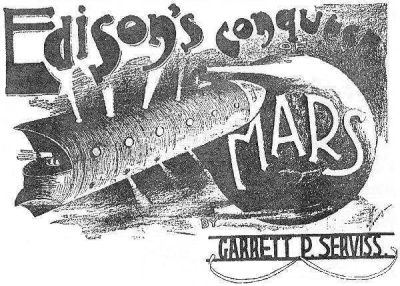Terrible Swift Sword
Edison’s Conquest of Mars
By Garrett P. Serviss

22 Sep, 2019
Garrett P. Serviss’ 1898 Edison’s Conquest of Mars is a sequel to 1897’s Fighters from Mars, or The War of the Worlds in and near Boston, which was a version of H. G. Wells’ The War of the Worlds rewritten and dumbed down by persons unknown in order to better suit Yankee sensibilities.
Having survived Mars’ first attack thanks to the Martian vulnerability to modern Terrestrial diseases, the people of Earth are alarmed when astronomers report that the foul Martians are preparing for a second foray. Mars has the technological edge; it is likely that they will be able to guard their second invasion force against disease.
Is Earth doomed? No. Earth has Thomas Edison.
Edison presents the world with a wonder weapon, a disintegrator even more powerful than the Martian lightning gun. Better yet, he has developed a means of electric propulsion that makes possible both airplanes AND spaceships. No need to fight off wave after wave of Martians after they reach the Earth. Earth can dispatch a fleet of electric spaceships to Mars, ships that can snuff the threat in its cradle.
There are obstacles, chief of which is financial. The grand fleet will not be cheap. Someone must pay. But a combination of self-interest and blind rivalry inspires world leaders to try to outdo each other in their support of Terrestrial defense. The funds are secured.
Once the fleet is constructed, Edison leads the expedition first to the Moon and then to Mars itself. Having no prior experience with space travel, the expedition suffers one setback after another. Meteors puncture ships; a roving comet drags the entire fleet back to Earth. Nevertheless, the humans persist. At long last Mars comes into view.
Mars is technologically advanced but environmentally threatened. They must husband dwindling resources. They have constructed a vast reservoir at altitude. If it were breached, say by a disintegrator, Martian civilization would be flooded and nigh destroyed. How do the Terrestrials know this? They have a well-informed local ally.…
~oOo~
Edison’s Conquest of Mars was rescued from well-deserved obscurity in the 1970s by Forry Ackerman. He needed inexpensive, sub-par material with which to pad out Ace’s dreadful translations of the Perry Rhodan space opera series. Lacking anything better to read, the younger James read this. It was dreadful. It is still dreadful. But it is of some historic interest and in many places it is bad enough to be risible.
I may have been unkind to Serviss in this review. Edison’s Conquest of Mars’ isn’t compatible with Wells’ War of the Worlds but the continuity errors between Wells’ novel and Serviss’ sequel that I blamed on Serviss may have in fact been the fault of whoever rewrote War of the Worlds for Cosmopolitan Magazine. Service’s fault may have been to write an unauthorized sequel to an unauthorized edition.
Serviss indulges in an impressive degree of namedropping. The expedition itself is joined not merely by Edison but also by Edward Emerson Barnard, Lord Kelvin, Wilhelm Röntgen, and Silvanus P. Thompson. The grand conclave on Earth features a wide ranging collection of named heads of state:
Queen Victoria
Kaiser Wilhelm
Queen Ravalona
King Malietoa
Czar Nicholas
Alphonso of Spain
Emperor Francis Joseph and the Empress Elizabeth, of Austria
King Oscar
Queen Sophia
King Humbert
Abdul Hamid of Turkey
Emperor Tsait’ien of China
Mutsuhito, the Japanese Mikado
and a gaggle of unnamed heads of state:
the President of France
the President of Switzerland
the First Syndic of the little republic of Andorra,
the heads of all the Central and South American republics
It’s a surprisingly diverse lot: pity Serviss couldn’t resist the occasional racist comment. The long list may also be evidence that he was being paid by the word.
The young human woman they discover on Mars is the descendant of humans removed by Martians from Earth ages ago. She speaks an Aryan tongue, or rather the Aryan tongue:
Her language every tongue that now upon the earth is spoken antedates. Convinced am I that it that great original speech is from which have all the languages of the civilized world sprung.
The scientists conclude her people must have come from the Vale of Cashmere, the cradle of Mankind! Oddly, although Cashmere (now known as Kashmir) is in South Asia, the lady herself is quite fair-skinned. Perhaps this is due to then millennia her people spent in Mars’ dimmer sunlight. Or perhaps it’s just racism on the part of the author.
Serviss was an astronomer and science popularizer, but he was rather gullible outside his field. Consider his take on archaeology: the Martians were active on Earth in ages past. They built the Pyramids and other archaeological wonders. It’s a plot point that makes me wonder if Stanley Weinbaum ever read Serviss.
Also note Serviss’ take on phrenology:
I was somewhat startled, then, in looking at the head and center of the great military system of Mars, to find in his appearance a striking confirmation of the speculations of our terrestrial phrenologists. His broad, misshapen head bulged in those parts where they had located the so-called organs of combativeness, destructiveness, etc.
Martian phrenology is absurdly easy: the Martians deliberately enlarge parts of their brains to better suit them to their chosen occupation. Or rather, the men do. The women do not, and are as a consequence rounded and reasonable individuals (who appear to have no voice in Martian governance).
Conquest is chock full of thrilling events, near-disasters, and spectacular acts of planetary genocide. The prose is ornate by modern standards, but does rattle on at a furious pace. The book is mercifully free of such luxuries as characterization. It is a novel in a style that connoisseurs of pulp fiction will find familiar.
Edison’s Conquest of Mars is available here (for free!).
